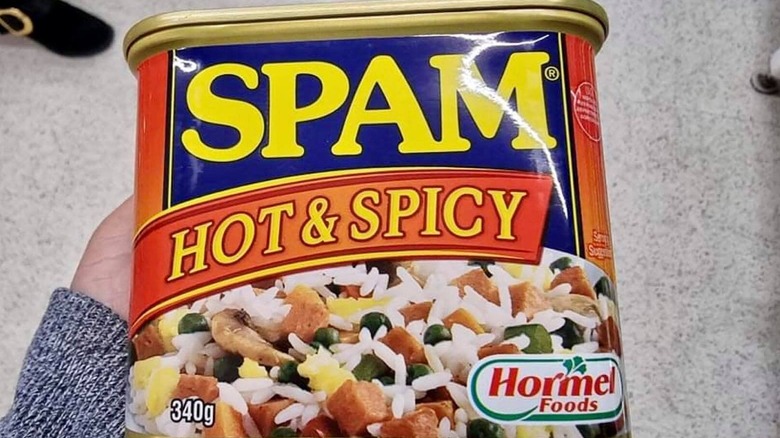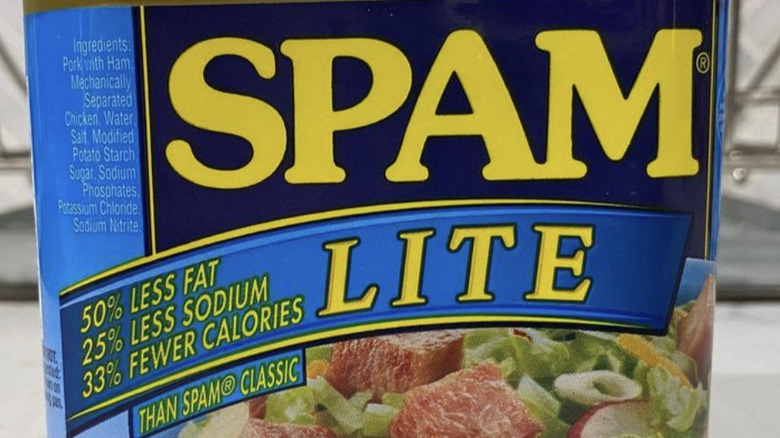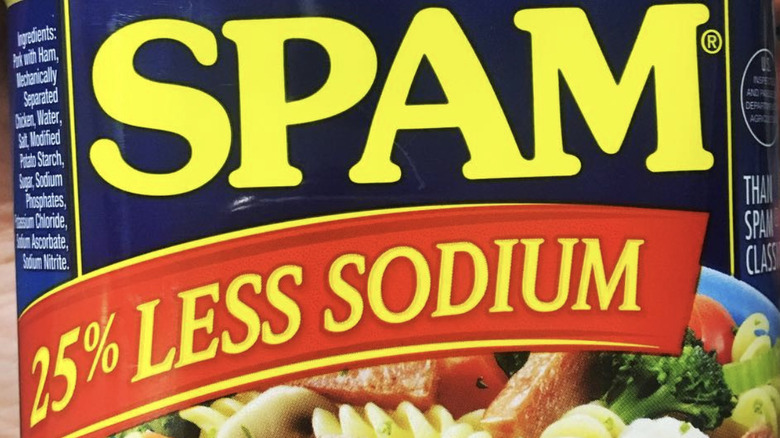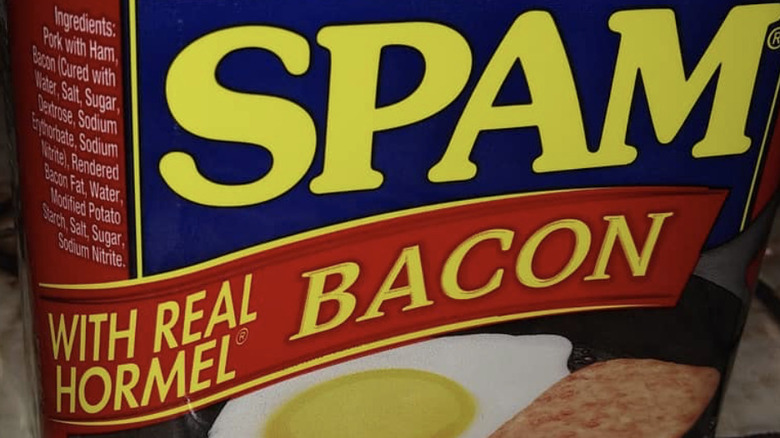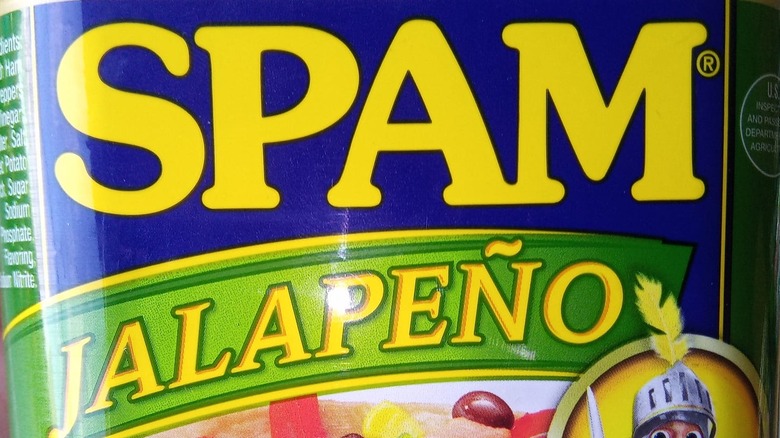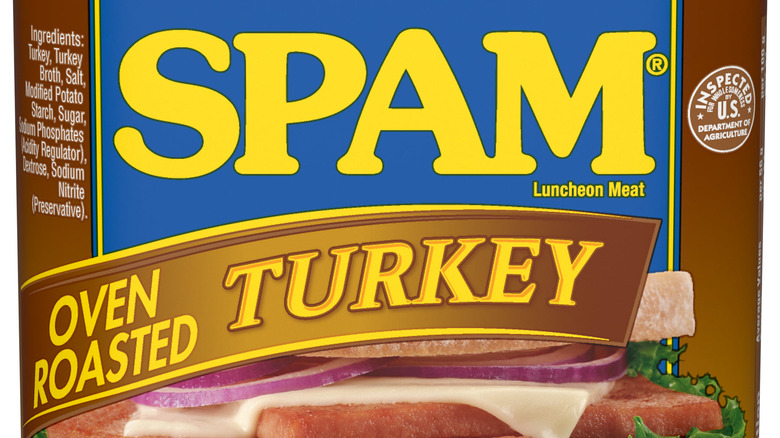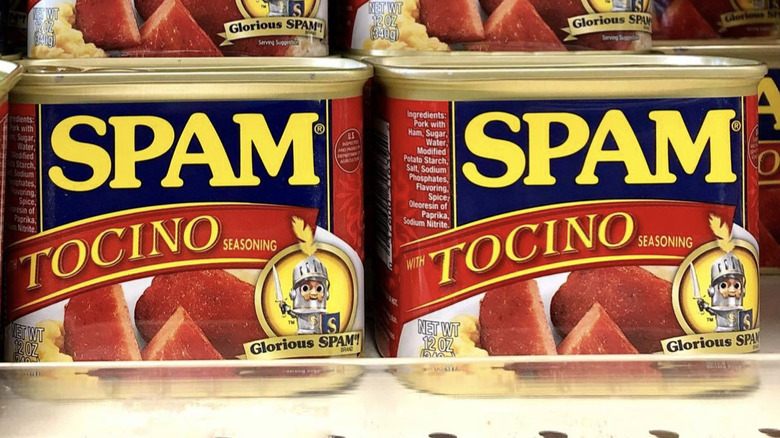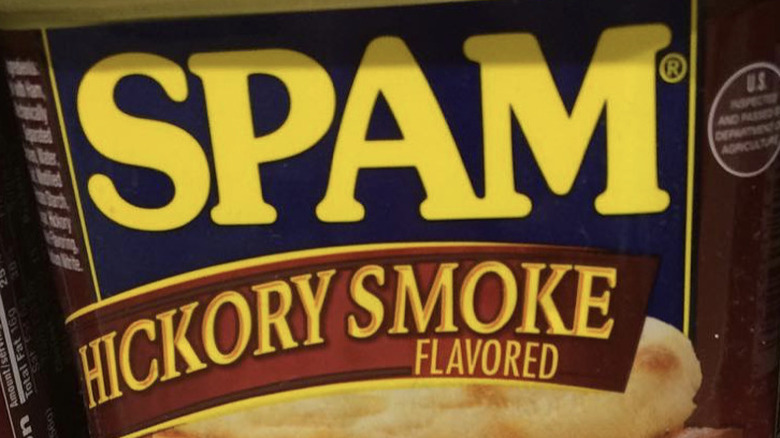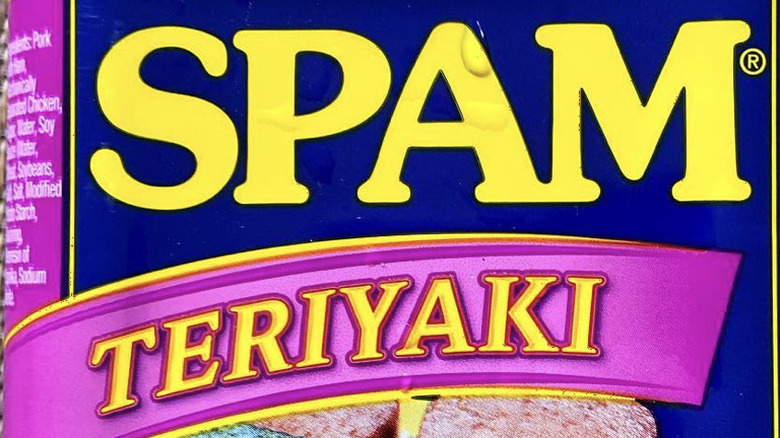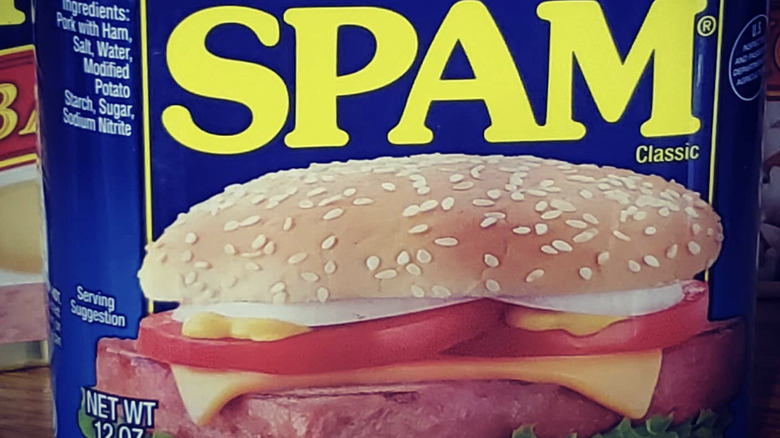Every Flavor Of Spam, Ranked From The Worst To The Best
The Hormel Corporation created Spam in the 1930s to provide an inexpensive animal protein source made from pork shoulder and ham, according to the Oxford Encyclopedia of Food and Drink in America. During and after World War II, the meat proved to be an easily shippable, shelf-stable, and inexpensive form of protein that came to be consumed around the world and made its way into local cuisine (as per Time).
But as the decades wore on, the idea of a squishy rectangle of meat became strange and comic. Spam became something of a joke, equated with "mystery meat," and persistent urban legends and rumors circulated regarding its supposedly real and horrifying ingredients. Nevertheless, a lot of people eat Spam, and they eat a lot of it. Hormel has sold more than eight billion cans of spam since its introduction in 1937.
Spam actually encompasses a whole product line consisting of numerous flavors and varieties bearing the household name of its franchise starter. Ten different kinds of Spam are widely available in the 2020s, and some are definitely better than others. We conducted research and numerous taste tests to figure out which flavors of Spam are the tastiest.
10. Spam Hot & Spicy
The Spam Hot & Spicy Spam flavor sounds like it offers a tantalizing blend of spice mixed in with the salty, fatty, porky familiarness of Spam: Finally, Spam with a kick, something to take it past comparisons to ham and bacon and into spicy sausage territory. Unfortunately, Hot N' Spicy Spam doesn't deliver on that promise or those expectations. This Spam is just a little bit hot and barely spicy: It appears that a very small amount of tongue-tingling, senses-igniting ingredients were added to the mix.
But there's a twist. Some spicy foods can take a moment to hit the tastebuds, and Hot N' Spicy Spam is the same. One bite of this Spam just burns a little bit before overpowering all of the inherent flavors in the Spam with a truly unnerving aftertaste. It's a difficult flavor to place or compare, but the taste is akin to the smell of a garbage can. If you're looking for a spicy variety of Spam then there are other varieties that can do the trick. Or, you can simply pick a different flavor and add some hot sauce. These are both better options than the pungent, stomach-churning Hot N' Spicy Spam.
9. Spam Lite
Spam is often imitated but never quite replicated. Every grocery store and dollar store product distributor in the country has its own take on Hormel's unique recipe and process. These iterations are sold on shelves right alongside the real thing and are often labeled "luncheon meat" or something similar, suggesting a canned pork concoction that's probably just as good as Spam or tastes almost exactly like it, except for a dollar less.
Strangely and ironically, one of Hormel's very own Spam offshoots comes very close to replicating that texture and flavor. Spam Lite is objectively healthier than the original Spam because it's made with less pork fat and sodium, and it tastes like a no-name, generic Spam substitute. Spam contains very few ingredients, and removing any of these messes with what makes it so special and singular. Spam Lite is essentially Spam that has been excised of fat and salt. It tastes close enough to Spam but not quite close enough.
8. Spam Less Sodium
Pork and salt complement each other very well. It's hard to think of a delicious preparation of pork that doesn't involve the use of added sodium in some way, whether it's pork belly, bacon, canned ham, real ham, glazed ham, Slim Jims, or Spam: Salt helps the umami of pork products come alive and shine. You can always taste the salt in these products, but it functions more as the wind beneath the wings of the delicious, meaty, fatty taste of pork.
Taking the salt away from a pork dish does theoretically make the food healthier. After all, too much dietary sodium is bad for blood pressure. However, taking the salt away from Spam also makes the product rather unnecessary. Why even eat pork, or more specifically, Spam, if you don't want the sodium? Salt makes Spam happen: It's relevant to the preparation and the preservation, but it also factors into the distinctive flavor of Spam. The main issue with Spam Less Sodium is that it tastes like Spam Classic without the salty kick, which takes away the distinctive taste of Spam altogether.
7. Spam with Real Hormel Bacon
Spam with Real Hormel Bacon is a pork product that's supposed to carry the flavor of bacon. It's also a way for the manufacturer to promote its fresher line of meats, particularly bacon. And even though Spam with Real Hormel Bacon is aggressively touted as containing actual cured and smoked pork belly (that's what bacon is), the end result doesn't actually taste like real bacon.
Spam with Real Hormel Bacon tastes like imitation bacon or that vaguely bacon-suggesting taste that's commonly found in bacon-flavored products like snack chips. This makes for a Spam-bacon hybrid that tastes mostly like real Spam and sort of like fake bacon. The notes of bacon in this Spam mostly ring false. There just isn't enough bacon flavor present in this product, and you probably won't notice it unless you really concentrate on what you're eating. Overall, this variety of Spam is not really worth trying: You'd be better of just eating some bacon.
6. Spam Jalapeño
If we're comparing the two fiery varieties of Hormel's canned rectangular pork product, then Spam Jalapeño is easily superior to the Hot and Spicy Spam. While the spicy elements of Hot and Spicy Spam are murky and decidedly not delicious, the spicy taste of Spam Jalapeño is obvious, direct, and abundant. The meat brick has little green speckles that are actual chunks of hot jalapeño peppers.
The peppers add a kick that mingles nicely with meaty and salty flavors without overwhelming the overall taste of the product. Textural confusion isn't a factor either: If the jalapeños are cut into overly large pieces, then they can be overly slimy or crunchy (depending on how finely they're cut and how long they're cooked). Luckily, the peppers in this product are chopped finely enough to impart an elevation of flavor and an injection of spiciness without changing the mouthfeel or texture of the Spam whatsoever.
5. Spam Oven Roasted Turkey
Every other flavor of Spam tastes mostly like the original classic full-fat and full-salt Spam because all those varieties are working with the same archetype. However, the Oven Roasted Turkey Spam is the only Spam flavor that isn't made with any sort of pork product at all. Oven Roasted Turkey Spam is ostensibly the healthiest form of Spam: It's made with naturally low-fat poultry meat, which contains far less fat, cholesterol, and calories than its Spam brethren made from one of the fattier parts of the pig.
Hormel seems to have used much of the same Spam manufacturing and packaging technologies for the Turkey variety because it has exactly the same texture and mouthfeel as the real thing. Even the blend of spices and additives makes it taste almost like pork Spam. It's the equivalent of turkey bacon or a veggie burger in that it performs a pretty good impression of the real thing, but it must be considered independently and not as a replacement. So while Oven Roasted Turkey Spam does imitate the original Spam quite well, it also doesn't taste like "Oven Roasted Turkey." It ultimately tastes like really thick lunchmeat or a thick stack of deli counter turkey.
4. Spam with Tocino Seasoning
Spam with Tocino Seasoning is a bit harder to find in the U.S. than it is in the Philippines. Hormel took inspiration for the Spam variety from a popular Filipino breakfast dish called burong babi or tocino (via Manila Sun). Burong babi is sometimes derived from pork belly or pork shoulder: "Tocino" is the Spanish word for bacon. The dish consists of cured and sweetened pork with the thick, chewy consistency of jerky, and it is often served with rice and eggs
Spam with Tocino doesn't go down like jerky: It has the consistency of Spam because that's the base ingredient. This flavor is treated with an array of sweet, smoky, and peppery flavors that gives the Spam a reddish shade, making it a fairto-good facsimile of the Filipino favorite. Spam with Tocino actually tastes like Spam with hints of brown sugar and paprika. It's a different and very pleasant alternative to the usual flavors of Spam that are commonly found in supermarkets.
3. Spam Hickory Smoke
One would expect Spam with Real Hormel Bacon to have a smoked pork taste with the right amount of salt. However, that's actually the flavor profile of the Spam Hickory Smoke flavor. This Spam flavor doesn't really taste like pulled pork, which is to say that it has the taste of an unprocessed pork shoulder left to slowly cook and get its flavors to mature in a backyard smoker. This Spam tastes like it has been left inside a low-heat, wood-fired cooker until the meat, smoke, salt, and pork have all mingled together in equal measures.
Spam Hickory Smoke boasts a prominent though subtle taste of actual wood smoke. It certainly doesn't taste like artificial smoke or liquid smoke-style flavoring agents. The end result, even when it's consumed cold or right out of the can, is a Spam flavor that's a little sweet (if not caramelized), mildly spicy, and extremely tangy. It tastes like smoked pork shoulder smushed together with everyday bacon and ham. When this Spam is prepared hot, it offers a reasonable, no-fuss alternative to a Sunday dinner ham.
2. Spam Teriyaki
Spam is extremely popular in Asian countries. It's a staple part of diets in modern culinary traditions across the world, particularly Hawaii (via Hormel). Spam is featured on the menus of numerous different Hawaiian restaurants both on the islands and the U.S. mainland, often starring as the meat in a teriyaki-style fry-up. Spam that has been treated with teriyaki sauce, either as a marinade, applied during cooking, or drizzled on after, is a delightful and ideal marriage of savory and sweet, and Spam Teriyaki surprisingly and fantastically captures that restaurant or home-cooking result.
Spam Teriyaki packs the most flavor out of all the different flavors of Spam. It packs the most flavor, and it has noticeable hints of moistness. Spam Teriyaki is a saucy ingredient, and if it's used to cook up with rice, it doesn't need much extra sauce added, if any. Even when this Spam is served cold, it tastes like it comes from a Hawaiian lunch spot.
1. Spam Classic
Classics are classics for a reason, and the regular, tried-and-true, no-frills Spam Classic is definitely the best Spam variety out there. Hormel came up with this classic at a time when it must have seemed strange and coldly postmodern. Spam mostly consists of ham and pork shoulder processed and treated with a wallop of sodium to help ensure it maintains freshness over time and the distance from the factory to the consumer's kitchen. And while Spam has predecessors in the canned meat sector, like tuna and corned beef, there really isn't anything like this wonder of pork and salt.
Even the main flaws of Spam are actually its strengths. Is Spam extremely salty? Yes, but that's what helps make it scientifically possible. The saltiness also makes Spam taste like bacon. While the gelatinous goop that surrounds the pink brick can be a little bit off-putting, that's just an indicator that it's made of real meat, despite the industrial precision characterizing every other element of the product.
Spam is reminiscent of ham, bacon, and other breakfast meats, but it winds up having its own special taste that's like an extra thick and far meatier version of bacon and ham. It's more flavorful and decadent than anything one would find at Easter dinner or at the deli counter.

